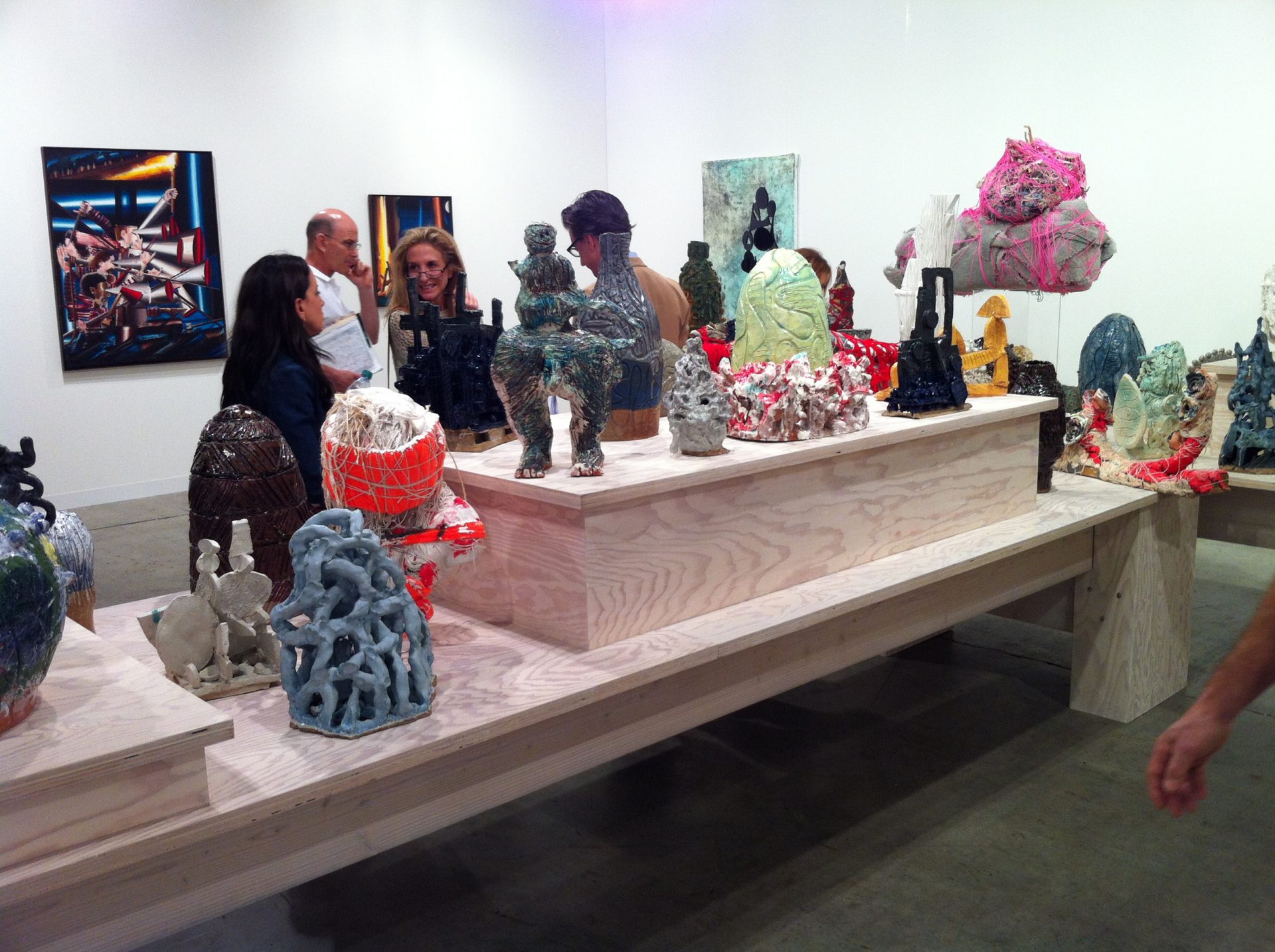By Dorothy Jenkins Fields
Special to The Miami Herald
Art Basel 2010 in Overtown was an opportunity missed. No shuttle provided round trips from Miami Beach to Overtown and little media alerted patrons or residents about the exhibitions. The art fair was headquartered in Miami Beach, but neighborhoods like Wynwood and Midtown buzzed with parties and art sales at satellite events. Across the railroad tracks in Overtown, the streets were quite as artists with museum quality art waited hopefully.
The Overtown Youth Center, 450 NW 14th St., hosted the first exhibition, Dec. 2-3: A Retrospective of Paintings by artist Joseph C. Grant Jr., curated by Mary McBeth. The exhibit depicted life through the eyes of a young black male from the inner city. Originally from Trinidad, Grant grew up in Brooklyn’s Bedford-Stuyvesant and recently relocated to Miami.
The Kuumba Artists Collective of South Florida curated two exhibitions: “African Roots/African Fruits: New and Recent Works by Florida African World Artists” in Wynwood, Art Space, 2085-B, NW 2 Avenue, Artlab33. It was an exhibition of diverse works from 14 of the region’s most creative painters, draftsmen, photographers and sculptors. “The Original Florida Highwaymen,” classic landscape paintings by seven African American artists, mostly from the Fort Pierce area, was exhibited in Overtown’s Ward Rooming House Gallery, 249 NW Ninth St. Kuumba’s signature catalog, produced by Dinizulu Gene Tinnie and Altine, profiles each artist.
The Kuumba Collective also hosted the Kinad African American Mobile Museum featuring the “Old Masters of African American Art,” including Jacob Lawrence, Romare Bearden, Elizabeth Catlett, Sam Gillan and Henry Ossawa Tanner and John Biggers. The full size bus, converted into a museum setting, was parked Dec. 3 at the Ward Rooming House Gallery and Dec. 4 at Wynwood’s Art Space. Operating since 2001 Kinad, a community based organization, is best known for its educational programs. This mobile museum makes learning fun by introducing young and old to hundreds of little-known black history facts.
Several works were exhibited at historic churches. Photographs by James Forbes and Marvin Week’s “The Colored Town Gallery: Paint The Story Installation” were in an outdoor space at the historic Mt. Zion Baptist Church, 301 NW Ninth St. Addonis Parker presented Art Forever Studio’s “Eyes of the Soul” at the historic St. John Baptist Church, 1328 NW Third Avenue. This group of 11 artists included Miamians Wanda Paulette and Charles Humes Jr.
The ninth edition of Art Basel Miami Beach closed Dec. 5 with few art patrons or residents seeing the works of thirty-five (35) African American artists made possible by grants from the Miami Community Redevelopment Agency. The CRA issued $100,000 in grant money for local exhibits within the CRA boundaries targeting the visual and performing arts.
The date for the 10th edition of Art Basel Miami Beach is set, Dec 1-4, 2011.
Organizers have the opportunity to begin the next decade by including the high-quality works of regional African American artists in Art Basel Miami Beach, the premiere international art show in the Americas.
Dorothy Jenkins Fields, PhD, is a historian and founder of the Black Archives, History and Research Foundation of South Florida Inc. Send feedback to djf@bellsouth.net.
Response: First, please correct gallery name to “Artlab33 Art Space,” not as is posted here.
Second, if CRA monies were to assist in this effort, they was administered far too late to make a significant difference.
Third, with so much happening in the “official” Art Basel Miami Beach agenda (20+ satellite art fairs), is it realistic to expect people to travel outside the designated art areas? Visitors to Art Basel Miami Beach would expect that if the art was really that important, significant, or worthy of viewing, it would be part of the official, or semi official events. Design Miami moved from Miami Design District to Miami Beach to eliminate the travel from Miami Beach and back, and they had transportation provided by Braman BMW. People were turned away from Flagler Island for the art projects presented there, but the art had to seen only by traveling there by boat. “The Island” was definitely off the beaten track, but it was part of the “official” art events which traveled here from Los Angeles.
Fourth, we need to honestly, and critically examine ourselves and ask why we have not been more successful in these efforts, and seek viable resolutions to having the kind of success we want. It’s not as simple as saying “they” missed an opportunity, because “we” didn’t develop, plan, market, and/or implement our end of the deal. That, of course, is not to say those things were not done, but were they done well enough to attain the success as we are now measuring it?
I’ve called for more concerted efforts and am willing to help develop some strategies. This has to start now, not mid-October, or later.
